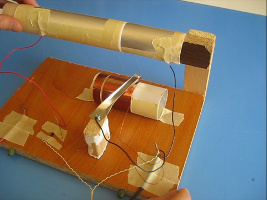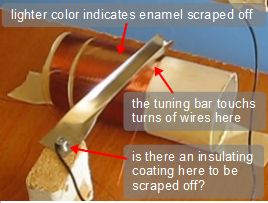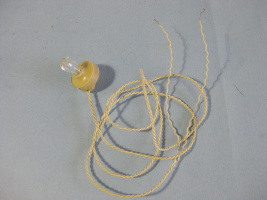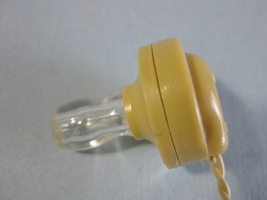Crystal radio tips and tricks
Below are detailed tips and tricks for getting your crystal radio to work.
- Tip 1 - Use a long, straight antenna
- Tip 2 - Use a good ground
- Tip 3 - Check all your electrical connnections
- Tip 4 - The diode must be a germanium diode
- Tip 5 - Use a crystal earpiece/piezo earpiece
- Tip 6 - Test your crystal earpiece/piezo earpiece
- Tip 7 - Test your crystal radio with an amplifier
As well, here's a video that also goes through many of the crystal radio tips and tricks on this webpage (though there are a few on this page that aren't in the video).
Tip 1 - Use a long, straight antenna
A crystal radio's antenna should be as long as possible. A car antenna won't work. I've managed to get a wire around 12 feet/4 meters long to work, but I live near a few radio stations. In general, the farther away your radio stations are, the longer the antenna has to be.
The antenna should be straight, though you'll likely have some near the crystal radio itself which isn't lined up with the rest of it.
Pointing it at a radio station gives best results for picking up that radio station, but that isn't always possible and so it isn't likely you'll be doing that.
The antenna can be any type or size of wire, but it should be electrically insulated from other metal or other electrically conductive things (e.g. water).
I've succeeded in putting multiple same-length wires in parallel and connected together only at the crystal radio. It seems to help as long as the wires are separated by at least around 4 inches/10cm.
Tip 2 - Use a good ground
A ground is a thing that is a good source or sink of electrons i.e. it gives electrons freely and also takes them if you want to give it electrons instead. Some good grounds are as follows.
Grounds - The Earth
The Earth is a good ground, but you have to make good electrical contact with it in order to use it. Ground that is dry is not a good electrical conductor and so it's hard to make good electrical contact with it. Wet or damp soil is better since water makes it a good conductor. A temporary way of improving the conductivity of the Earth ground is to pour water into it.
Connecting to the Earth ground can be done in a variety of ways:
- Pound a few feet/meter of copper rod down into the ground or bury it, or bury a long bare wire (it doesn't have to be straight.) Then connect to that rod or wire.
- Connect to pipes that are already going into the ground. For example, the cold water pipes in your house may go to the ground. However, the entire path from where to connect to the pipe to where the pipe goes into the ground has to be metal. If there's a teflon valve or something similar along the way that breaks the metal path then that's no good.
- Connect to a metal fence with metal fence posts that go into the ground. But once again, it must be metal all the way from where you connect to it to where it goes into the ground.
- Electrical sockets/receptacles that you plug your appliances into
have a ground hole. In North America the socket has two straight
holes and a half-round hold. That half-round hole should ultimately
be connected to Earth ground, if your house is wired correctly.
To use that in a relatively safe manner, I buy a standalone
plug from a hardware store and connect just one wire to the ground
prong on that plug. I insert the plug into the electrical socket
and connect my crystal radio ground connection to the other end
of the wire.
Not all house sockets have a good ground. My building is old and only one of mine does.
Warning: This is a dangerous way to get a good ground unless you know what you are doing, otherwise get help from someone who is qualified in household electrical wiring.
Ground - Your body as an okay ground
Your body is also an okay ground and will often help if you have no other ground around. To use it as a ground you want to make contact with as much of your body as possible. In the photo below I'm using my portable crystal radio and you'll notice that my left hand is on the aluminum foil plate which makes up the outer cylinder of my capacitor. That plate of the capacitor is the one that would normally be connected to an Earth ground if one was available. I'm making as much skin contact as possible with it.

Tip 3 - Check all your electrical connnections
Go over every place where you've connected a wire to something or two wires together or two metal objects that should be touching and make sure they are in fact touching and are doing so firmly, not loosely.
Some of these places may not be obvious. For example, if you have a tuning coil as shown in the photo below then the tops of the tuning coil have had their enanmel insulation removed from them and the underside of the tuning bar should be making contact with one or maybe two turns of wire. It's easy to think that it is but in reality it might not be making good contact. Just make sure you don't sand too much insulation from the tops of the coil turns -- you don't want the metal from the wires of adjacent turns to be touching each other, or at least not for too many other them. Two adjacent turns that are in electrical contact with each other when you sanded them count as just one turn.
Also, whatever piece of metal is being used as the tuning bar may have a coating of some sort that acts as an electrical insulator, preventing electricity from flowing to/from it. Make sure to scrape any coating off before connecting anything to it, and that includes where it makes contact with the coil.


Tip 4 - The diode must be a germanium diode
The doide you use must be a germanium diode and not a silicon diode. Germanium diodes are harder to find but I've bought them from local electronics stores and by ordering them online. There are many places to get them online.
Some examples of diodes that work are: 1N34, 1N34A, 1N60, 1N91, 1N119, 1N270, 1N277, 1N283. You can also look for what are called "equivalent" diodes to any of these.
Some online sources are:
Tip 5 - Use a crystal earpiece/piezo earpiece
For most crystal radio circuits you need to use crystal earpieces, also known as piezo earpieces


You can buy these online. Here are some sample sources:
You can also make some that work fairly well. This page shows you how to make your own crystal earpieces.
You can use ipod style earbuds as well but you'll have to modify the crystal radio a bit. I show you how to use earbuds here.
Tip 6 - Test your crystal earpiece/piezo earpiece
You can test your crystal earpiece by removing it from the crystal radio such that it's not connected to anything. With the earpiece in your ear, tap the type exposed, metal wire ends of the earpiece together. You should hear a clicking sound.
Tip 7 - Test your crystal radio with an amplifier
One of the most fun aspects of a crystal radio is that it gets its power from the incoming radio waves -- no batteries! But if you're not hearing anything then it could be working but the sound is just too faint to hear. In that case, remove the crystal earpiece from the circuit and replace it with an amplifier. An amplifier is powered from batteries or from the wall socket and so can make a faint sound loud enough to hear.
That doesn't help you fix your crystal radio but at least you'll know if it's working or not.
The amplifier can be a store-bought one or it can be a homemade one. On this page, I show how to make an amplifier and how to connect it to the crystal radio. A store-bought one would connect in the same way.
